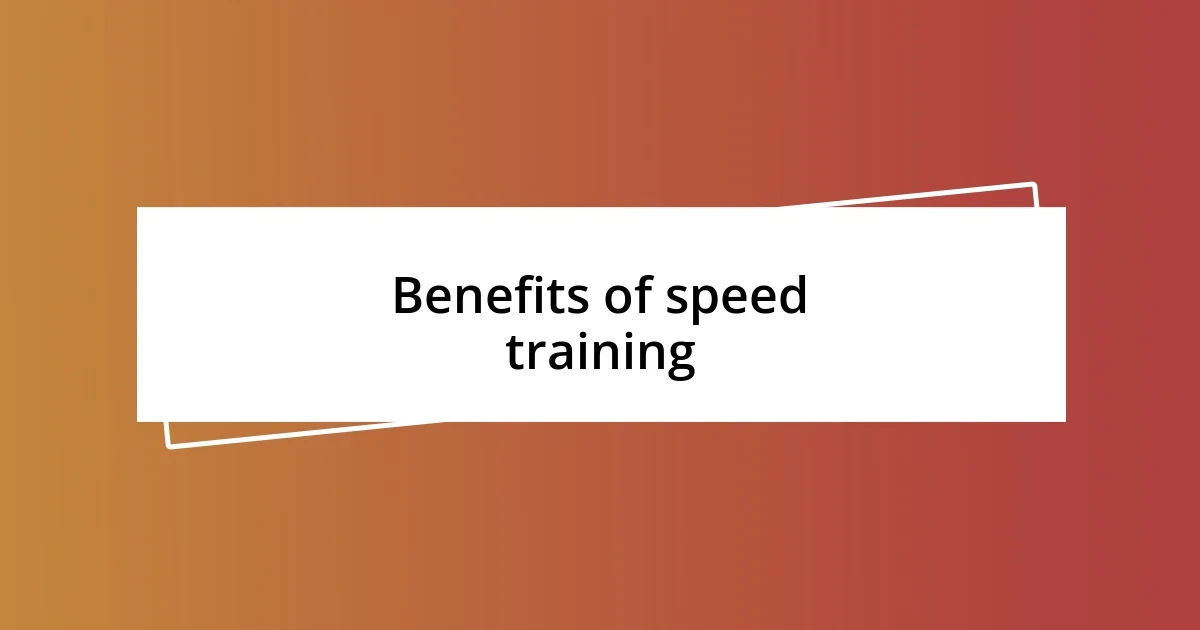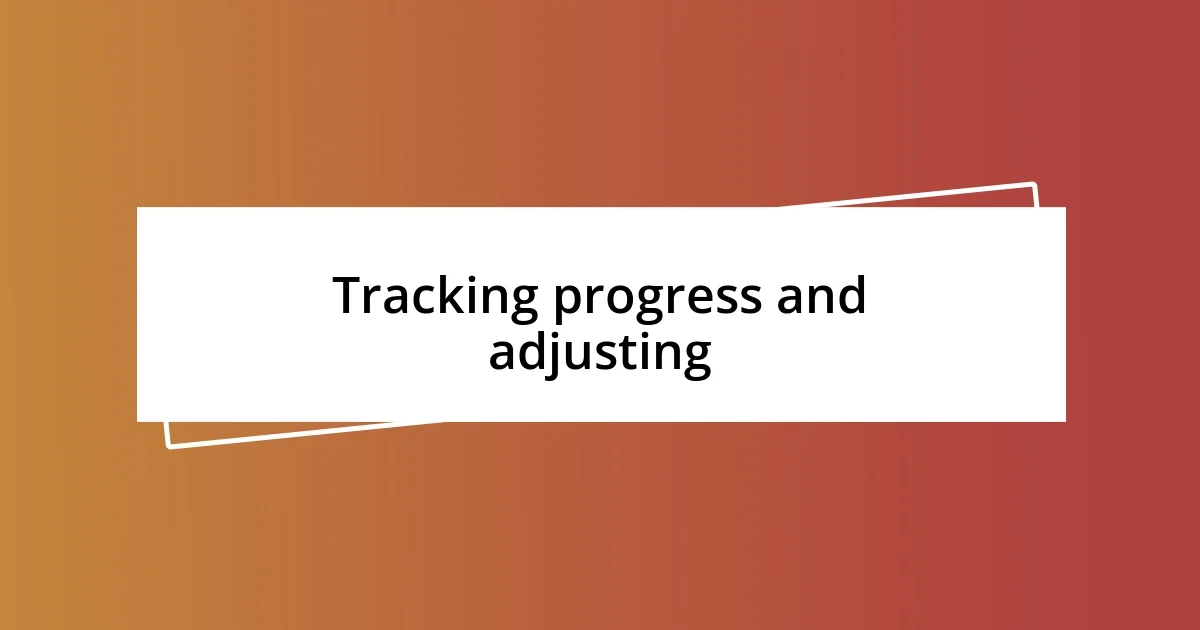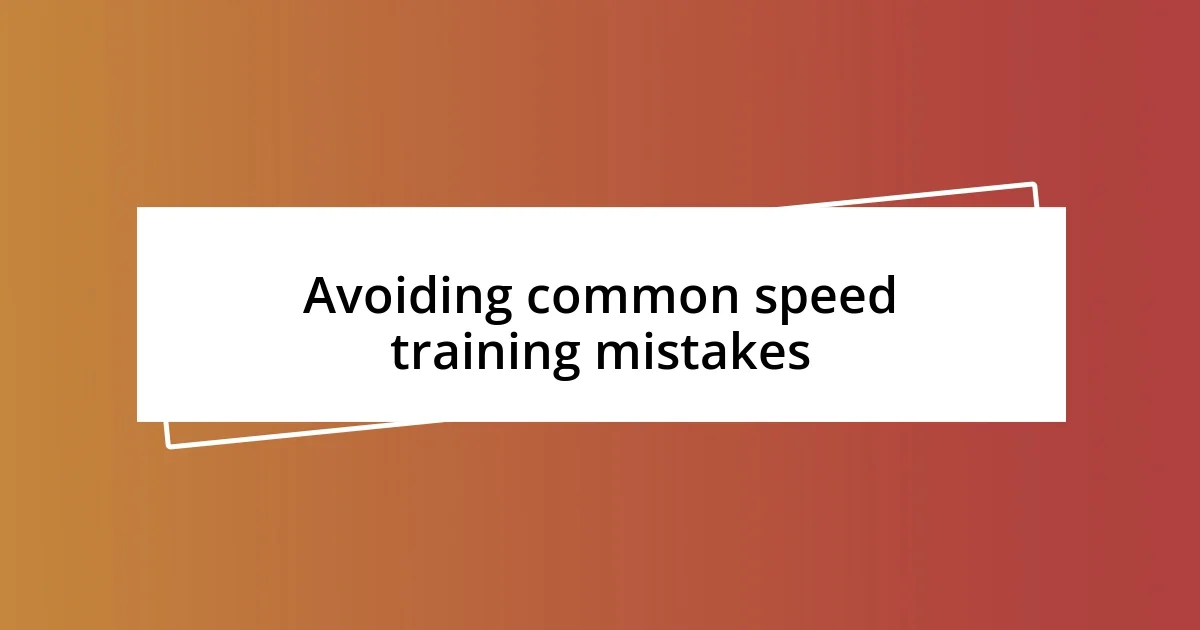Key takeaways:
- Understanding speed work principles involves balancing intensity with recovery, utilizing specificity in workouts, and mastering pacing strategies for optimal performance.
- Speed training enhances running economy, builds mental toughness, and adds enjoyment to the training process, making it a fulfilling aspect of running.
- Incorporating effective techniques, tracking progress, and avoiding common mistakes like overtraining and improper warm-ups are crucial for successful speed training outcomes.

Understanding speed work principles
Understanding speed work principles requires a focus on both intensity and recovery. I remember the first time I incorporated intervals into my training—it was a game changer. The feeling of pushing my limits, followed by that sweet relief during the recovery phase, taught me the importance of balancing effort with rest.
The principle of specificity also plays a vital role in speed work. When I trained for my first 5K, I noticed how different types of workouts, like hill sprints and tempo runs, developed distinct aspects of my speed. Isn’t it fascinating how our bodies adapt to these targeted efforts? Each workout serves a purpose, aligning with my overall racing goals.
Lastly, understanding pacing is crucial. I often find myself reflecting on my race strategy during speed sessions. How do I want to feel in the final lap? This thought process helps me find my rhythm, ensuring that I maximize speed without overexertion. It’s all about learning to embrace the discomfort while staying mindful of my limits.

Benefits of speed training
Speed training offers a plethora of benefits that can enhance overall performance. From my experience, one of the most significant advantages is improved running economy. When I started incorporating speed workouts, I noticed that I could maintain a faster pace for longer periods. It’s remarkable how even a few weeks of dedicated speed training can rewire your muscles and make running feel more efficient.
Another crucial benefit of speed training is the boost it provides to mental toughness. I still remember the days when I dreaded those tough interval sessions, often filled with doubt and hesitation. However, as I pushed through, I began to unlock a new level of confidence. Each sprint felt like conquering a mental barrier, helping me to approach races with a positive mindset and a ‘can-do’ attitude.
Finally, let’s not overlook the joy and excitement that comes with speed training. There’s something exhilarating about chasing after your personal bests. I often find myself grinning ear to ear after completing a successful session, fueled by adrenaline and satisfaction. Speed work transforms running into a thrilling adventure, and the progress intertwined with these efforts keeps the passion alive.
| Benefit | Description |
|---|---|
| Improved Running Economy | Increases efficiency, allowing longer distances at faster paces. |
| Mental Toughness | Builds confidence and resilience through challenging workouts. |
| Increased Enjoyment | Transforms training into exciting challenges and adventures. |

Effective speed workout techniques
When it comes to effective speed workout techniques, I’ve found consistency and variety to be key. I remember experimenting with different interval formats, like 400-meter repeats and 800-meter split runs. Each session brought a unique challenge, and embracing that diversity made the workouts feel fresh and exciting. It wasn’t just about the physical push; I also learned valuable lessons about pacing and how to listen to my body during these high-intensity bursts.
Thinking back, here are some of the techniques that have helped me immensely:
- Interval Training: Alternate periods of high effort with recovery. This doesn’t just train your muscles; it also sharpens your mental resilience.
- Fartlek Runs: Incorporate bursts of speed into a steady run. This playful approach kept things fun for me as I chased the light poles or trees.
- Hill Repeats: Sprinting uphill builds strength and speed. I could feel the burn, but the payoff, both in my endurance and power, was worth every painful step.
Harnessing these techniques has not only elevated my speed but also deepened my connection to running. Every session becomes an opportunity for growth, both physically and mentally.

Creating a personalized speed plan
Creating a personalized speed plan starts with understanding your unique goals and current fitness level. I remember when I first tried to set my targets; I had to be honest about my abilities. It’s easy to get caught up in lofty aspirations, but I found that tailoring my plan to something realistic helped me progress without feeling overwhelmed. So, what are your specific targets? Define them clearly, as this will be your guiding star.
Next, I recommend incorporating a variety of speed workouts into your routine. I vividly recall the excitement of trying out different sessions—mixing tempo runs with sprint intervals kept my motivation high. It allowed me to discover what truly worked for my body. Exploring these variations can not only prevent burnout but also uncover hidden strengths you didn’t know you had. Have you ever stepped outside your comfort zone during a workout? The rewards often outweigh the apprehension.
Finally, don’t underestimate the power of recovery and adaptation in your speed plan. Initially, I thought pushing harder was the only way to improve, but taking rest days and listening to my body made a dramatic difference. I learned that a well-rounded approach, balancing effort with recovery, ultimately leads to better performance. What steps are you taking to ensure you’re allowing your body to recover? By prioritizing this aspect, you lay the groundwork for sustainable success in your speed training journey.

Incorporating recovery strategies
Recovery strategies are often the unsung heroes of speed work. I’ve had my fair share of pushing too hard without enough rest, and let me tell you, the aftermath was not pretty. There were days when I could barely put one foot in front of the other, and I realized it wasn’t just my muscles that needed a break; my mind was begging for it too. Have you ever felt that burnout creeping in after weeks of intense training? Taking a step back, either with an easy run or simply a day off, completely transformed my workouts once I incorporated recovery into my routine.
One recovery technique that made a real difference for me was active recovery days. Instead of just lounging around, I would opt for a light jog or even a brisk walk. I vividly remember one Sunday morning, when I chose to go for a gentle bike ride instead of hitting the pavement hard. The fresh air and change of scenery uplifted my spirits. I found myself returning to my speed workouts feeling rejuvenated and eager to tackle challenges. It got me thinking—what if more runners embraced such gentle forms of movement?
Stretching and foam rolling became my best friends, too. After particularly grueling sessions, I’d dedicate time to rolling out my quads and hamstrings, often while listening to my favorite podcast. I can’t stress enough how much these practices helped reduce soreness and enhance my flexibility. Have you incorporated recovery methods into your routine? Trust me, giving your body that care can revolutionize your approach to running.

Tracking progress and adjusting
Tracking progress is essential if you want to see real improvement in your speed work. I remember starting out with a simple spreadsheet to log my times and workouts; it felt tedious at first, but that data genuinely opened my eyes. I could finally see patterns emerging—some days I performed significantly better than others, and figuring out the “why” behind that became an intriguing puzzle. What metrics are you tracking? Identifying key performance indicators like pace or recovery time can make a world of difference in understanding your progress.
Adjusting your plan based on tracked progress is where the magic happens. For instance, after a couple of months, I noticed my interval times were plateauing. Instead of sticking to the same routine, I decided to incorporate hill sprints, inspired by a friend who swore by them. That tweak not only reignited my enthusiasm for training but also translated into faster flat times. Have you made any adjustments based on your training outcomes? Being flexible is crucial; when you see what’s working or what isn’t, don’t hesitate to pivot.
I also found it helpful to reflect on my emotional state during training sessions. I recall one time when I was feeling particularly drained—my workouts reflected that slump, with slower paces and lack of focus. After assessing my progress, I realized it was time for a mental reset, which led me to schedule a week of light, enjoyable runs. Sometimes it’s not just the physical adjustment that counts, but also the mental shift. How do you feel during your workouts? Tune into those feelings; they can provide invaluable insights that numbers alone may not reveal.

Avoiding common speed training mistakes
It’s so easy to fall into the trap of overtraining when you’re aiming to boost your speed. I remember one season, I was so focused on hitting those faster paces that I neglected to listen to my body. I wound up with nagging injuries that sidelined me longer than I expected. Have you ever noticed how fatigue can creep into your performance and impact your motivation? I started deliberately incorporating rest days, and it felt like a light bulb moment—my speed improved when I allowed myself that essential downtime.
Another mistake I often see is skipping the warm-up. Initially, I thought jumping right into speed drills was the way to go, but I learned the hard way how crucial it is to prepare your body. During one of my speed sessions, I didn’t properly warm up and ended up straining a muscle mid-workout. It was a setback that took weeks to recover from. Now, I ensure I include dynamic stretches and easy jogs to get my heart rate up. How do you warm up before your workouts? Taking even just 10 minutes to prime your muscles can set the tone for a successful session.
Lastly, I’ve noticed a lot of runners underestimate the importance of pacing during speed workouts. I used to think going all out from the start would yield the best results, but that often led to burnout halfway through. I remember one excessively ambitious track workout where I came out flying, only to crash and burn by the final heats. Now, I consciously pace myself, using intervals to gauge my efforts and preserve energy for the last push. Have you found your own pacing strategy? It’s all about finding that sweet spot between pushing boundaries and maintaining a sustainable effort.














